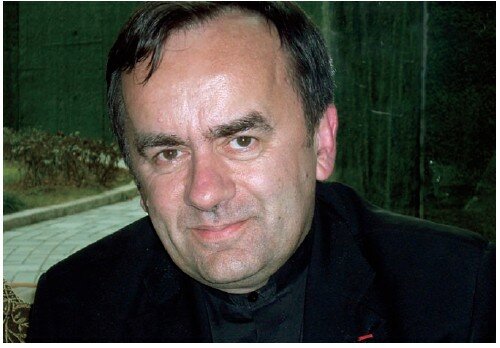| Father Desbois the memory keeper |

|

|
|
In January 2011, The Hong Kong Holocaust and Tolerance Centre (HKHTC) welcomed Father Patrick Desbois, author of the book and documentary film Holocaust by Bullets. Father Desbois was the keynote speaker for the community’s United Nations Holocaust Day Memorial Ceremony. He also partnered with the HKHTC and spoke to 2000 students at 15 different schools in the area. Father Desbois is a Catholic Priest living in France, who has dedicated his life, with uncompromising determination, to uncover the truth behind the deaths of over 1.5 million Jews exterminated by Nazi mobile units in the Ukraine, Belarus, Russia and Poland during the Second World War.
He is the President of the Yahad In Unum Foundation (it means together in both Hebrew and Latin), the Director of the French Conference of Bishops for Relations with Judaism, Advisor to the Cardinal Archbishop of Paris and Advisor to the Vatican on the Jewish religion. For Father Desbois this line of work began as a private family matter. In July 1942 his grandfather was deported to a German camp of Soviet prisoners in a small village called Raba Ruska. When his grandfather finally spoke he told Father Desbois “It was awful; no food, no drink, but outside the camp it was worse.” Later Father Desbois went back to Raba Ruska to understand what happened. “I knew they had shot 18,000 Jews in this small village. After three years and a new mayor, Father Desbois was finally introduced to witnesses who gave their testimony. He discovered the Holocaust had been a public event. People had witnessed the crimes and they remembered everything. This realisation became a responsibility to “find these witnesses and to interview them in a professional format, so that we could keep their memory.” After this experience Father Desbois “discovered nobody had done this work and it was impossible to do it when it was the Soviet Union because we had no archives.” He and his team started to work with the Holocaust Museum in Washington which provided them with access to Soviet and German archives, which sometimes had maps of the graves and other relevant information. With this information he and his team would build a file for each village before they went to the location looking for witnesses and in search of the mass graves. They would arrive at a village quietly with two unmarked vans. They would knock on people’s door and ask, “Where you here during the war? And where you present at the shooting? Then if they said yes we began to chat with them. Many of them wanted to speak and asked why we hadn’t come earlier.” During the interviews Father Desbois listened with the sensitivity of a priest and probed with the curiosity of a detective. His aim was to unleash the truth and the truth of those who perished. “We tend to say Holocaust like we say tsunami, but it is not the same and less so in the Soviet Union because every victim saw the killer and every killer saw the victim. This was a personal crime. There was no machine, no trains and no camp. We want to re-establish this genocide as personal with concern for the victims and not the killers.” For the team, the real task was to rebuild each crime and to find out how the Germans ran the operation, where were the killers standing, how did the different families arrive, from which direction and finally how were they killed and what was the location of the mass grave. Once a grave is found, evidence is collected and information is then transmitted to the American Jewish Committee and the German government. Because according to Jewish law they cannot unbury people, the challenge is to collect the evidence and then protect the area. On a few occasions they have covered the grave with cement and written that Jews are buried there, the day of the shooting and the number of victims. To date a team of 22 people work full-time. Every month a team of 9 people go out for 17 days. The team includes an interpreter,a ballistic expert, a photographer and an archival researcher. So far the team has covered over 70% of Ukraine; they have combed through 3 regions in Belarus and 2 regions of Russia. They have interviewed 1,700 witnesses and Father Desbois says, “There is still a lot we have to cover.” Father Desbois explains they have found most of the graves of the victims of the Einsatzgruppen, however in the next few years those who were witnesses will no longer be around to tell their story, so time is of the essence. He strongly believes that his work will be finished in the next 5 to 6 years. Family foundations in the US, Canada and France have supported Father Desbois’ work. The Yahad In Unum is also partially supported by the European Commission and last year they were heavily supported by Germany, but not any more. They also have the help from the Church. “For example, I was in Poland last year and the Cardinal of Paris sent a letter to the Archbishop of Lublin and for the moment they protect us,” he said. In Poland all the information they gather is shared with the Chief Rabbi of Poland, Rabbi Schudrich. When explaining the differences between Rabbi Schudrich’s work and his, he said, “The difference is that we don’t only look for the mass graves, we record the testimony. The real challenge is to keep the evidence so that tomorrow nobody will be able to deny the crime.” Denial is the greatest problem because Father Desbois feels that “little by little the Holocaust begins to be a belief and so we are afraid that in 10 years people will say ok maybe the Holocaust perhaps existed and in any case the Jews believe in it. But it is not a belief, it is a fact, it is history,” and here is the evidence to prove it. That is why he treats every location as a crime scene. The work Father Desbois and his team have done has been filmed and became a documentary, shown during primetime on French television. They also created a travelling exhibit, which includes pictures and their research, which has been shown in most European cities and New York. And are considering a small exhibit for Asia. When speaking about the rise of anti-semitism and our continuous repetition of genocide, Father Desbois said that sadly, it is the killers that have learned from genocide and how to improve it. “I think Ahmadinejad is learning a lot about Hitler and so on, but for the rest of the population I’m not so sure.” When he says he wants to destroy Israel “we can’t turn away and say it’s nothing; it is very dangerous because we have to remember he is the president of a state.” In terms of those who deny the Holocaust, Father Desbois expressed that the first to do so were the chiefs of the Nazis, like Heinrich Himmler. At the end of the war they thought they would have a problem and decided to unbury and burn the corpses in secret, however they weren’t finished before the Red Army arrived. They were the first, “and the followers are only their sons and to deny is a way to continue Nazism. It is not an intellectual position it is an anti-semitic position. The problem is that they show themselves as pseudointellectuals and some people believe them. I think we’ll have less witnesses and more deniers; that is why it is so important to bring evidence, then there is no question.” The goal of Yahad In Unum is to “show that there is no crime without evidence and to teach to the non-Jews that genocide is a strong disease of humanity that has come back many times. The main challenge now is to network with other organisations to see how we can work to prevent genocide in the future.” Through the Holocaust we learn that for any genocide to occur those who commit the crime have to abolish the commandment not to kill. Hitler wanted not only to abolish this commandment but he wanted to eliminate all the people who followed this commandment - the Jewish people. The larger task is to bring this home to non-Jews and prevent the next genocide from happening. (Interviewed by Jessica Zwaiman Lerner) (Issue February 2011) |
















 Often called the ‘memory keeper,’ Father Desbois uses forensic evidence, eyewitness accounts and access to archival material to create the first definitive account of one of history’s forgotten chapters. He has devoted his life to combating antisemitism, teaching people about genocide and furthering the relationships between Catholics and Jews.
Often called the ‘memory keeper,’ Father Desbois uses forensic evidence, eyewitness accounts and access to archival material to create the first definitive account of one of history’s forgotten chapters. He has devoted his life to combating antisemitism, teaching people about genocide and furthering the relationships between Catholics and Jews.